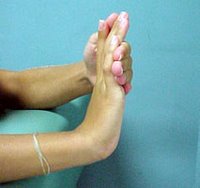Hold back your vomit. The only thing that is revived with the coming of warm weather is motivation, in other words the POWER TO CRUSH! It is true that the seasons are finally changing; snow melting from top-outs, icicles dripping off bolts, and rivers
finally breaking away from the ice-encrusted surface. In just a few weeks, it will be time to send your projects and boost your climbing skills to the next level! Damn, I sound like an uppity version Eric Horst.
In either case, as you vibrate with excitement to push the limit, you must remember to pay close attention to your body; specifically, your pulleys and flexor tendons since these areas are the most vulnerable. After accumulating many debilitating injuries over the years due to ignorance and selfishness, I have come to develop a simple system that has kept me healthy thus far (3 or 4 days). Hopefully, the following tips can help you maintain strength and stear clear of danger zones because there is nothing worse than being injured, except maybe a smooshed piece of chocolate cake or Valentine’s day.
For those of you hard-asses out there that already know this stuff, or perhaps never get injured, I have a golden medallion for you in my North Face backpack. More importantly, the following advice is not copy and pasted from some ridiculous medical book of bullmalarkey jargon; instead, the information is gathered from experience, a few subtle techniques I wish to pass on in hopes that they can help you in the same way they have helped me.
You'll be climbing harder than Fred Nicole and Josune Bereziartu in no time! Not really.
1) Make a bowl of ice water and a bowl of hot water. After every training session, no matter how intense, ice and heat for twenty minutes by alternating your hands between each bowl…
This will alleviate swelling and promote healing by decreasing the amount of excess fluid in the joints and tendon sheaths. I have found that recovery is much more effective and efficient after such a treatment. You may think that ibuprofen would have the same effect, but this is not true. Ibuprofen has been proven to block or largely inhibit key enzymes that are crucial to tendon and muscle recovery. Those little red pills may make your fingers feel better, but this sensation is only temporary due to a mere decrease in inflammation. On nights that I have not climbed, I do not ice. Instead, I sleep with a heating pad wrapped around a particularly tender hand or finger. This may seem overzealous, but the technique has helped me recover from what may have been devastating injuries by keeping sore tendons loose and lubricated.
2) Whenever idle, massage as much as possible…
During these icing/heating sessions, it is important to rigorously massage the joints and pulleys. Any area with acute pain will greatly benefit from regular massage. Rubbing with Vitamin E or some sort of Neosporin lubricates the surface, creating a more efficient and effective massage. Chicks will dig your smooth hands too. It is important to know that this type of therapy is only useful in the beginning stages of pain. There comes a point where your pulley or tendon will not benefit from massaging because of permanent tearing or prolonged overuse. But regularly working on your fingers and forearms will help to fend off such tears by maintaining the elasticity of continuously abused tendons.
3) Stretch and warm-up, and then stretch some more!
The only thing more important than warming up is stretching. Imagine soaking an elastic band, putting it in the freezer over-night, and wripping it out in the morning only to pull on it as hard as you can. The elastic will probably snap. Same goes for your tendons. Of course human anatomical elasticity is far greater than a silly rubber band, but you get the point. If you neglect to warm up and stretch, you mine as well take a hammer and pound away on your fingers. Stretching before, during, and after training sessions is imperative. Below are a few simple techniques that work very well.
(In the pictures below, the entire hand is stretched out. Be sure to stretch out each finger individually, up and down/side to side)




4) On rest days…REST!
This is an obvious component to recovery, but is regularly neglected by the over-ambitious. Getting eight hours of sleep is usually impossible, but nonetheless, vital to solid recovery. On your rest days, stay away from campus or finger boards. Just because it is not climbing does not mean that it will not hurt you. In fact, pushing finger’s on rest days will only put recovery time back even further, potentially creating micro-tears that will open the gates to disaster. It is difficult to do absolutely nothing on rest days, but any sort of finger training or small of amount of climbing is just flirting with injury. I prefer to run, lift, or play some other sport on these days to abate the hunger to climb. Most importantly, the first sign of pain in a pulley or tendon must not be ignored. Usually, one to two weeks can alleviate pain almost completely. Ignoring these warning signs for just a week could mean the end of entire season.
Most of this therapy may seem obvious or perhaps you already practice such techniques. However, maintaining this system of recovery with the same commitment to detail and devotion you apply to training and climbing is equally important, if not more so than climbing itself. These tips are extremely subtle, yet exceedingly effective over a long duration of time. Basically, a regular regimen of such therapies and paying attention to detail is what has kept me off the couch and allowed me to continue to punish myself indoors and outdoors.
Good luck and have fun! Stay healthy!







